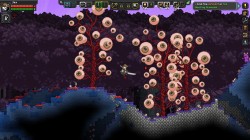Culture | August 17th, 2016

By Ben Haugmo
benhaugmo@yahoo.com
I move on from the Avian village, crates and chests looted in plain sight of the ambivalent feathery locals, to continue searching for surface caches of the mineral durasteel. On my way out of town I help one of the townsfolk by walloping a nearby bandit warlord. Things take a turn for the strange when I encounter a forest made up of, not trees, but what appear to be eyes on stalks. Well, the spaceship’s computer did say there was radiation in the area.
This is Starbound, Chucklefish’s spacefaring sandbox game, finally receiving its official release after five years of development. Twenty hours into my first playthrough, I have a feeling that eyeball forests are only scratching the surface of what this game has to offer.
There’s a lot to do in Starbound. The game involves the typical survival sandbox fare of a linear progression of tools, weapons, and armor, with each upgrade allowing for the acquisition of the next tier of equipment. Players will be doing a lot of gathering as they shoot for the next level of gear.
True to convention, Starbound also has construction elements. Materials can be placed to build structures, and with enough money, a colony deed can be purchased to compel non-player characters to move in and enjoy the player’s pursuits in interior and exterior design.
Much of the gathering and building is accomplished with an item called the matter manipulator. This device is where Starbound begins to deviate from convention. The matter manipulator consolidates many of the gathering tools usually found in sandbox games.
Rather than being required to carry a pickaxe for mining and an axe for cutting down trees, each of these tasks is accomplished by this one device.
There’s farming. Seeds can be collected and planted in tilled soil, the resulting crops either crafted into food or sold for profit. Livestock can be reared to make gathering certain resources less of a far-reaching task. There’s exploring other planets.
So far, I really enjoy Starbound, and a lot of that is due to it being a new take on one of my favorite games, Terraria. Both games are 2D sandboxes with gathering, building, and crafting elements. The similarities should come as no surprise. After all, Chucklefish’s team is headed by a former Terraria developer.
Much of my criticism of Starbound comes from where it fails to build on Terraria’s formula. Crafting stations, for instance have to be selected one at a time to access recipes. In Terraria, you merely had to be standing near a furnace in order to smelt a metal bar, and could just as easily select the recipe to hammer it into a chest piece. In Starbound, players have to select the furnace, exit the crafting interface, and then select their anvil in order to accomplish the same.
Another issue is the fact that Starbound’s inventory management is a little tedious. A later update to Terraria allowed items to instantly be moved from the player’s inventory to nearby containers, if the same item was already in that container. Starbound requires that items be placed in lockers and chests individually, rather than all at once. This unstreamlined inventory management can slow the pace of a player’s space adventures.
It could be argued that Terraria has been “officially” released for a longer period of time, and that it’s therefore had more time to innovate, but Starbound has spent years in development, and was already working from Terraria’s very solid concept. My hope is that Chucklefish will at least sort out inventory management in a later update, if not the interface issues.
One final place Starbound fails to stack up to its predecessors ties into one of its most alluring mechanics: The space exploration. Interstellar travel is great, and discovering new planets is great, but it’s this broader scope that could also inhibit Starbound.
In Terraria, players have one world to explore, and build up a base slowly over time, attracting unique NPCs with specific functions to live in new rooms as they’re constructed and progression requirements are met. Starbound has plenty of planets to explore, but because I’m urged to explore each one, I have yet to really ground myself and establish a home in Starbound. I threw up a shack on my starter world, planted some corn and some carrots, coaxed someone into living on that newly-broken ground, and then moved on to new territory. I return to that small starter house once in awhile to check on the crops, but I’ve had no incentive to really build it up. The NPC will send me on fetch quests occasionally, maybe toss some currency my way in thanks, but...
Arguably, the spaceship is more Starbound’s equivalent to Terraria’s base-building, since that’s where players spend most of their time as they explore, and the crew that you can recruit serves specific functions. Engineers can increase fuel capacity, there’s a person who will change the crew’s uniforms, heck, I managed to hire an onboard janitor.
Even with all these nitpicks, even though Starbound isn’t quite “Terraria in space,” I’ve still had a lot of fun with it. I wouldn’t have put in 20 hours otherwise. There’s plenty of things to strive for in the game. I look forward to when my interstellar travels are over and I can finally focus on building up a colony, Starbound’s reality my canvas and the matter manipulator my brush.
Starbound is currently available for $14.99 online. If you’re partial to crafting, building, and exploring the cosmos, it is well worth the price.
December 18th 2025
October 20th 2025
October 15th 2025
September 16th 2025
July 29th 2025
_(1)__293px-wide.png)
_(1)_(1)_(1)__293px-wide.jpg)
_(1)__293px-wide.jpg)
__293px-wide.jpg)
__293px-wide.jpg)
